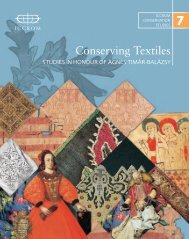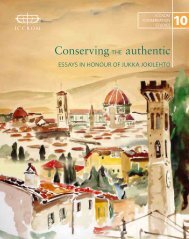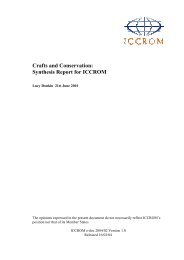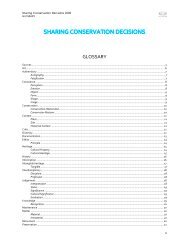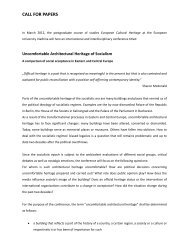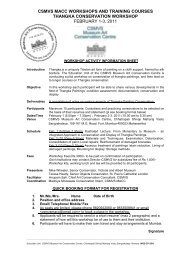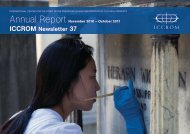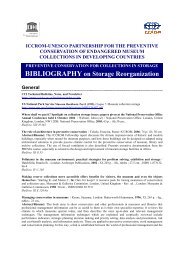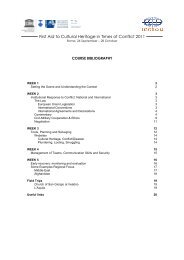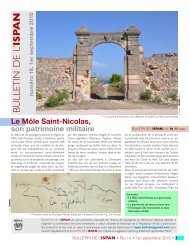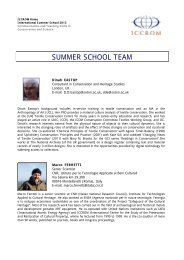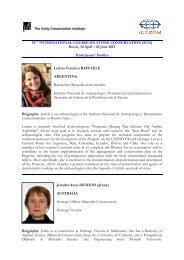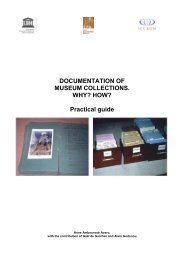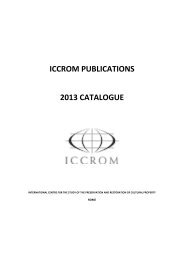part 1 - Iccrom
part 1 - Iccrom
part 1 - Iccrom
You also want an ePaper? Increase the reach of your titles
YUMPU automatically turns print PDFs into web optimized ePapers that Google loves.
MEASURING HERITAGE CONSERVATION PERFORMANCE<br />
6th International Seminar on Urban Conservation<br />
to the outside and changing between the wide-open<br />
and hot feira livre and the shady hall intense impressions<br />
in all dimensions of perception are made. A<br />
butcher said that this fluid flow of customers is (one<br />
of) the essence(s) of this feira. We realize that these<br />
‘spatial actions’ are one of the affecting conditions of<br />
Laranjeira’s market.<br />
The spatial score (or script) has become its colours,<br />
smells, sounds; its time, rhythm and the sequence of<br />
movements. If we want to express formation rules<br />
we may say that there is a main underlying structure<br />
that is pictured by the market’s vivid reality (or<br />
using a musical vocabulary: there is an always new<br />
improvisation like in jazz music; always new and<br />
different renditions of the same underlying theme<br />
or phrase). With its well-proportioned dimensions<br />
the width of a path allows narrowing it until a certain<br />
density is reached that creates a swarm of people<br />
and things. People move in a slower, sometimes<br />
pressed velocity and density changes to accommodate<br />
the situation, attractions and locality. In this<br />
traditional space the ‘communication’ or interaction<br />
between people and objects become a flowing line<br />
and network like the tune of a well-structured and<br />
formed musical composition.<br />
5. Understanding<br />
Practicing this kind of writing in the descriptive<br />
report is transferring and im<strong>part</strong>ing both observed<br />
facts and perceived impressions, founded on a<br />
detailed methodology and local examination.<br />
For the field research we defined 5 typical places<br />
(each sector ca. 10 x 10m) at defined pre-observed<br />
localities (with different products and spatial structure)<br />
and documented all equipment and details<br />
(‘hardware’), this is shown in Figure 6. Secondly,<br />
at defined moments (‘time-cuts’) we mapped all<br />
people in these sectors and their activities. Thirdly,<br />
we conducted short interviews with these customers<br />
within the same time period. Additionally<br />
in the same 5 sectors the sellers were interviewed<br />
as well as some professionals from the market<br />
organization, some jobbing workers, etc. Alongside<br />
other research, these interviews made it possible<br />
to get information about motifs, origins, products,<br />
customs, business background, periods of visits,<br />
organization details, etc. The knowledge of usage<br />
and its conditions explicate a typical scenario like<br />
a script, or formation rules (‘software’). The limited<br />
possibilities of this paper (and of the INRC-project)<br />
do not allow for discussion and practice of more<br />
sociological, psychological, behavioural, urban and<br />
architectonic methods that have been developed by<br />
scientists from the first environmental approaches<br />
of the humanities. Meanwhile there exist a wide<br />
range of methods and techniques that deepen and<br />
enhance socio-spatial approaches and their possible<br />
results in order to understand complex real<br />
situations at different levels and from different<br />
perspectives. We see a lot of methods and concepts<br />
such as Roger Barker’s ‘behavioral setting’, Kurt<br />
Lewin’s psychologischer Lebensraum [‘psychological<br />
Figure 6. The five sectors of local survey and the workflow diagram.<br />
Brendle, K. H. 2012. ¿Conservar uma feira livre? Or, preserving dynamic, complex heritage by accenting societal character and sociospatial<br />
conceptualization. In Zancheti, S. M. & K. Similä, eds. Measuring heritage conservation performance, pp. 42-52. Rome, ICCROM.<br />
47



